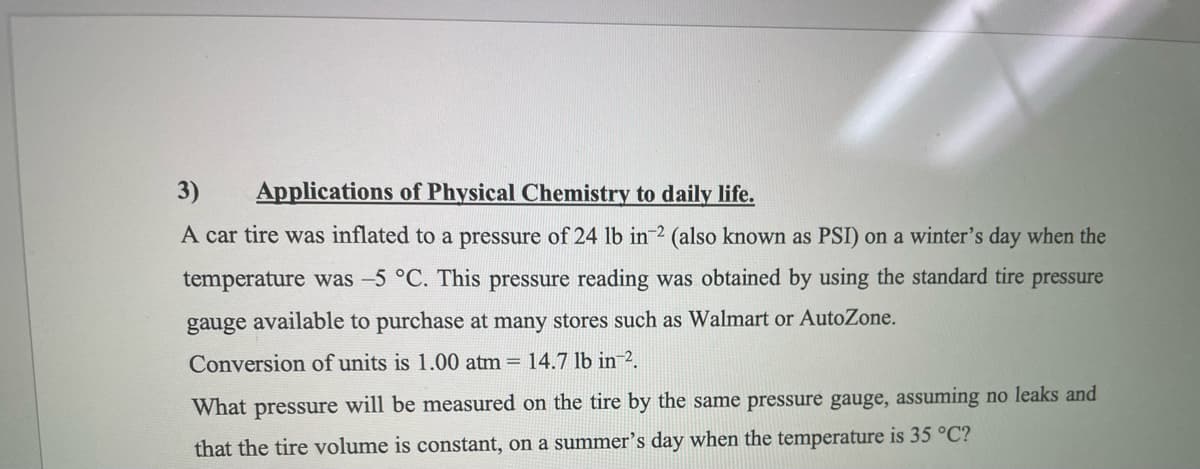A car tire was inflated to a pressure of 24 lb in-2 (also known as PSI) on a winter's day when the temperature was -5 °C. This pressure reading was obtained by using the standard tire pressure gauge available to purchase at many stores such as Walmart or AutoZone. Conversion of units is 1.00 atm = 14.7 lb in ². What pressure will be measured on the tire by the same pressure gauge, assuming no leaks and that the tire volume is constant, on a summer's day when the temperature is 35 °C?
A car tire was inflated to a pressure of 24 lb in-2 (also known as PSI) on a winter's day when the temperature was -5 °C. This pressure reading was obtained by using the standard tire pressure gauge available to purchase at many stores such as Walmart or AutoZone. Conversion of units is 1.00 atm = 14.7 lb in ². What pressure will be measured on the tire by the same pressure gauge, assuming no leaks and that the tire volume is constant, on a summer's day when the temperature is 35 °C?
Chemistry: Principles and Reactions
8th Edition
ISBN:9781305079373
Author:William L. Masterton, Cecile N. Hurley
Publisher:William L. Masterton, Cecile N. Hurley
Chapter5: Gases
Section: Chapter Questions
Problem 23QAP: Helium-filled balloons rise in the air because the density of helium is less than the density of...
Related questions
Question
Applications of physical chemistry to daily life

Transcribed Image Text:3)
Applications of Physical Chemistry to daily life.
A car tire was inflated to a pressure of 24 lb in-2 (also known as PSI) on a winter's day when the
temperature was -5 °C. This pressure reading was obtained by using the standard tire pressure
gauge available to purchase at many stores such as Walmart or AutoZone.
Conversion of units is 1.00 atm = 14.7 lb in ².
What pressure will be measured on the tire by the same pressure gauge, assuming no leaks and
that the tire volume is constant, on a summer's day when the temperature is 35 °C?
Expert Solution
This question has been solved!
Explore an expertly crafted, step-by-step solution for a thorough understanding of key concepts.
Step by step
Solved in 2 steps with 2 images

Knowledge Booster
Learn more about
Need a deep-dive on the concept behind this application? Look no further. Learn more about this topic, chemistry and related others by exploring similar questions and additional content below.Recommended textbooks for you

Chemistry: Principles and Reactions
Chemistry
ISBN:
9781305079373
Author:
William L. Masterton, Cecile N. Hurley
Publisher:
Cengage Learning

Chemistry: The Molecular Science
Chemistry
ISBN:
9781285199047
Author:
John W. Moore, Conrad L. Stanitski
Publisher:
Cengage Learning

Chemistry
Chemistry
ISBN:
9781305957404
Author:
Steven S. Zumdahl, Susan A. Zumdahl, Donald J. DeCoste
Publisher:
Cengage Learning

Chemistry: Principles and Reactions
Chemistry
ISBN:
9781305079373
Author:
William L. Masterton, Cecile N. Hurley
Publisher:
Cengage Learning

Chemistry: The Molecular Science
Chemistry
ISBN:
9781285199047
Author:
John W. Moore, Conrad L. Stanitski
Publisher:
Cengage Learning

Chemistry
Chemistry
ISBN:
9781305957404
Author:
Steven S. Zumdahl, Susan A. Zumdahl, Donald J. DeCoste
Publisher:
Cengage Learning


Chemistry: An Atoms First Approach
Chemistry
ISBN:
9781305079243
Author:
Steven S. Zumdahl, Susan A. Zumdahl
Publisher:
Cengage Learning

Physical Chemistry
Chemistry
ISBN:
9781133958437
Author:
Ball, David W. (david Warren), BAER, Tomas
Publisher:
Wadsworth Cengage Learning,